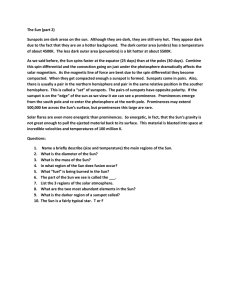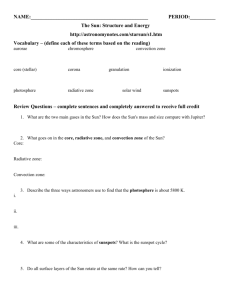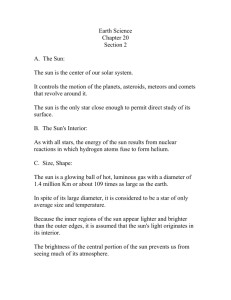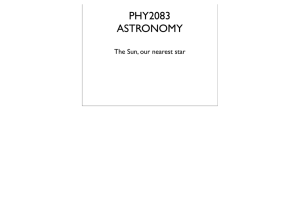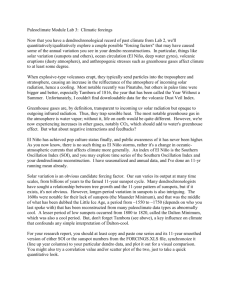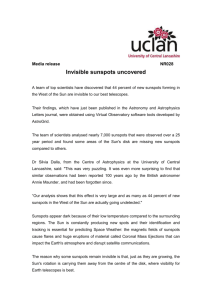sunspot cycle
advertisement
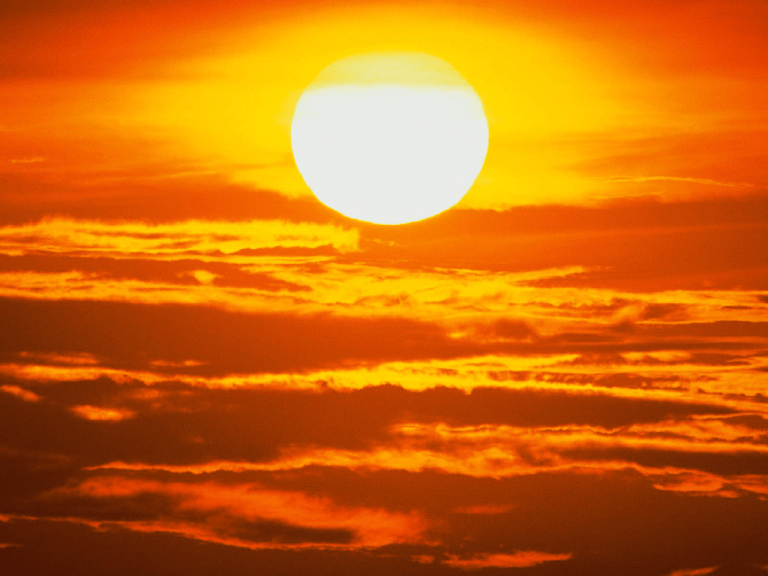
Most of the sunlight we see from earth comes from continuous photosphere emissions. These emissions make up the “quiet sun”. The active sun is sporadic, unpredictable radiation. It is characterized by explosive outbursts, but the active sun contributes little to the total light emitted by the sun. Sunspots are dark areas on the sun’s surface. They average 10 000 km across (about the size of earth). Sunspots often occur in groups; the sun may have 100’s or more at one time. Sunspots have an umbra, a dark center; and a penumbra, a grayish area around the umbra. Sunspots are cooler areas of the photosphere.An umbra is about 4500K, a penumbra is about 5500K. Sunspots seem dark because they are seen next to hotter regions of the sun’s surface; about 6000K. Sunspots change size and shape, they may fade out completely. A spot may last from 1 to 100 days. A group of spots typically lasts 50 days. Spots move across the sun’s surface indicating the sun’s rotation speed. The sun exhibits differential rotation, it rotates faster at the equator. The photosphere rotates once every 27 days at the equator. It rotates once every 31 days at the poles. Sunspots are sites of concentrated magnetic fields (1000x the undisturbed photosphere regions). They are the strongest known naturally occurring magnets in the solar system. Sunspots may be cooler because fields block the normal upward convection of the hot gases. Sunspots almost always exist in pairs with opposite polarity. All the sunspot pairs in the northern hemisphere have the same polarity. In the southern hemisphere all the pairs have the opposite polarity of the northern hemisphere. Differential rotation distorts the magnetic field, wrapping it around the equator. Eventually it loops and produces sunspot pairs. The solar cycle is a pattern of increasing and decreasing numbers of sunspots. Part of this is the sunspot cycle. Approximately every 11 years the sun has its maximum number of sunspots. Halfway between these times of maximum sunspots, there are almost no sunspots. The start of the cycle is called solar minimum. Four years into the cycle solar maximum is reached. The beginning of the next cycle appears to overlap the previous cycle. The solar cycle is actually a 22 year cycle composed of consecutive 11 year cycles. These consecutive cycles have opposite polarities of pairs of sunspots. From one 11 year cycle to the next the entire solar magnetic field reverses itself. Active regions are areas of violent eruptions around sunspots. They tend to be most violent around solar maximum. Prominences are loops or sheets of glowing gas ejected from an active region. These prominences move through the inner corona. There are two basic types of prominences: The first is quiescent prominences which are suspended by the magnetic field and can persist for days or weeks. The other type of prominence is an active prominence. These come and go more erratically; they may change in hours. They are typically some 100,000 km in extent (10 times Earths’ diameter). Flares are cataclysmic explosions on the sun, more violent than prominences. They are like bombs exploding in the lower regions of the sun’s atmosphere. A flare can release as much energy as a prominence, but it can do so in hours rather than days or weeks. (The particles in a prominence are held up by the sun’s magnetic field; the particles in a flare are blasted into space.) At sunspot maximum, the corona is an active corona. It is more irregular and extends further out into space than at sunspot maximum. The energy source of the sun is fusion - light nuclei combining to form heavier nuclei. Einstein’s theory of special relativity explains where the 2 energy comes from: E = mc . The extreme heat at the center of the sun 7 (10 K) is needed to force protons to move fast enough to fuse. The basic equations that occur inside the sun are called the proton-proton chain. Step (1): 1 H 1 2 1H + 1 H 1 --> 2 1H + positron + energy + 1 neutrino. is a deuteron, a positron is the antiparticle of a proton, A neutrino is a massless chargeless particle which can pass through several light years of lead. Step (2): A deuteron combines with a proton to form a helium nucleus: 2 1H + 1 H 1 --> 3 2He + energy Step (3): 3 2He + 3 2He 4 --> 2He + 1 H 1 + 1 H 1 + energy The net reaction is: 4 1 H 1 --> 4 2He + energy + 2 neutrinos The energy is in the form of gamma ray photons. The same basic process occurs for all stars. The number of neutrinos given off by the sun allows us to determine if the solar model is correct. Unfortunately, every measurement taken shows less neutrinos than expected. This is the missing solar neutrino problem and has three possible solutions: 1. The sun pulsates and is now at a low neutrino emission level. 2. Neutrino oscillations neutrinos leave the sun at the expected rate, but are changed to some other particle before detection. (This is the most accepted reason.) 3. Other materials influence the internal structure of the sun. (In other words, the solar model is wrong.) In conclusion, the sun is a mass of incandescent gas, a gigantic nuclear furnace where hydrogen is changed into helium at a temperature of millions of degrees. The sun is hot, the sun is not a place where we could live, but here on earth there would be no life without the light it gives.
